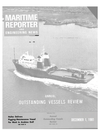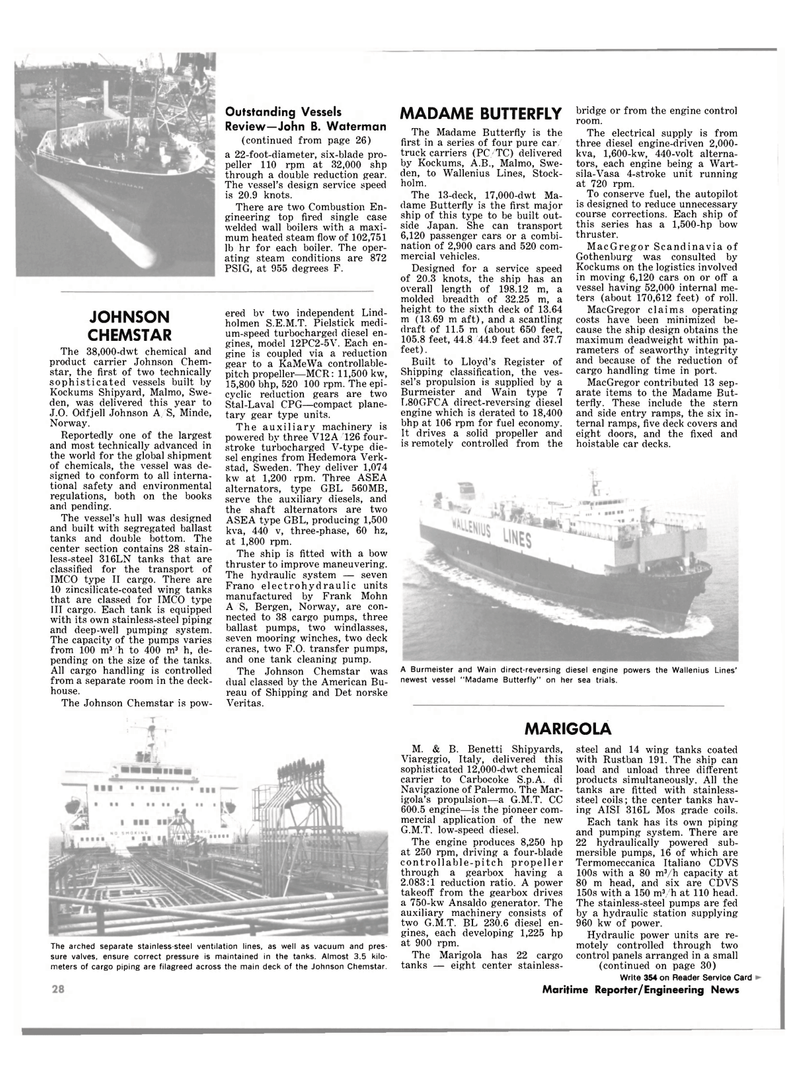
Page 22: of Maritime Reporter Magazine (December 1981)
Read this page in Pdf, Flash or Html5 edition of December 1981 Maritime Reporter Magazine
Outstanding Vessels
Review—John B. Waterman (continued from page 26) a 22-foot-diameter, six-blade pro- peller 110 rpm at 32,000 shp through a double reduction gear.
The vessel's design service speed is 20.9 knots.
There are two Combustion En- gineering top fired single case welded wall boilers with a maxi- mum heated steam flow of 102,751 lb hr for each boiler. The oper- ating steam conditions are 872
PSIG, at 955 degrees F.
JOHNSON
CHEMSTAR
The 38,000-dwt chemical and product carrier Johnson Chem- star, the first of two technically sophisticated vessels built by
Kockums Shipyard, Malmo, Swe- den, was delivered this year to
J.O. Odfjell Johnson A/S, Minde,
Norway.
Reportedly one of the largest and most technically advanced in the world for the global shipment of chemicals, the vessel was de- signed to conform to all interna- tional safety and environmental regulations, both on the books and pending.
The vessel's hull was designed and built with segregated ballast tanks and double bottom. The center section contains 28 stain- less-steel 316LN tanks that are classified for the transport of
IMCO type II cargo. There are 10 zincsilicate-coated wing tanks that are classed for IMCO type
III cargo. Each tank is equipped with its own stainless-steel piping and deep-well pumping system.
The capacity of the pumps varies from 100 m3/h to 400 m3 h, de- pending on the size of the tanks.
All cargo handling is controlled from a separate room in the deck- house.
The Johnson Chemstar is pow- ered bv two independent Lind- holmen S.E.M.T. Pielstick medi- um-speed turbocharged diesel en- gines, model 12PC2-5V. Each en- gine is coupled via a reduction gear to a KaMeWa controllable- pitch propeller—MCR: 11,500 kw, 15,800 bhp, 520 100 rpm. The epi- cyclic reduction gears are two
Stal-Laval CPG—compact plane- tary gear type units.
The auxiliary machinery is powered by three V12A/126 four- stroke turbocharged V-type die- sel engines from Hedemora Verk- stad, Sweden. They deliver 1,074 kw at 1,200 rpm. Three ASEA alternators, type GBL 560MB, serve the auxiliary diesels, and the shaft alternators are two
ASEA type GBL, producing 1,500 kva, 440 v, three-phase, 60 hz, at 1,800 rpm.
The ship is fitted with a bow thruster to improve maneuvering.
The hydraulic system — seven
Frano electrohydraulic units manufactured by Frank Mohn
A S, Bergen, Norway, are con- nected to 38 cargo pumps, three ballast pumps, two windlasses, seven mooring winches, two deck cranes, two F.O. transfer pumps, and one tank cleaning pump.
The Johnson Chemstar was dual classed by the American Bu- reau of Shipping and Det norske
Veritas.
MADAME BUTTERFLY
The Madame Butterfly is the first in a series of four pure car, truck carriers (PC/TC) delivered by Kockums, A.B., Malmo, Swe- den, to Wallenius Lines, Stock- holm.
The 13-deck, 17,000-dwt Ma- dame Butterfly is the first major ship of this type to be built out- side Japan. She can transport 6,120 passenger cars or a combi- nation of 2,900 cars and 520 com- mercial vehicles.
Designed for a service speed of 20.3 knots, the ship has an overall length of 198.12 m, a molded breadth of 32.25 m, a height to the sixth deck of 13.64 m (13.69 m aft), and a scantling draft of 11.5 m (about 650 feet, 105.8 feet, 44.8 '44.9 feet and 37.7 feet).
Built to Lloyd's Register of
Shipping classification, the ves- sel's propulsion is supplied by a
Burmeister and Wain type 7
L80GFCA direct-reversing diesel engine which is derated to 18,400 bhp at 106 rpm for fuel economy.
It drives a solid propeller and is remotely controlled from the bridge or from the engine control room.
The electrical supply is from three diesel engine-driven 2,000- kva, 1,600-kw, 440-volt alterna- tors, each engine being a Wart- sila-Vasa 4-stroke unit running at 720 rpm.
To conserve fuel, the autopilot is designed to reduce unnecessary course corrections. Each ship of this series has a 1,500-hp bow thruster.
MacGregor Scandinavia of
Gothenburg was consulted by
Kockums on the logistics involved in moving 6,120 cars on or off a vessel having 52,000 internal me- ters (about 170,612 feet) of roll.
MacGregor claims operating costs have been minimized be- cause the ship design obtains the maximum deadweight within pa- rameters of seaworthy integrity and because of the reduction of cargo handling time in port.
MacGregor contributed 13 sep- arate items to the Madame But- terfly. These include the stern and side entry ramps, the six in- ternal ramps, five deck covers and eight doors, and the fixed and hoistable car decks.
A Burmeister and Wain direct-reversing diesel engine powers the Wallenius Lines' newest vessel "Madame Butterfly" on her sea trials.
MARIGOLA
The arched separate stainless-steel ventilation lines, as well as vacuum and pres- sure valves, ensure correct pressure is maintained in the tanks. Almost 3.5 kilo- meters of cargo piping are filagreed across the main deck of the Johnson Chemstar.
M. & B. Benetti Shipyards,
Viareggio, Italy, delivered this sophisticated 12,000-dwt chemical carrier to Carbocoke S.p.A. di
Navigazione of Palermo. The Mar- igola's propulsion—a G.M.T. CC 600.5 engine—is the pioneer com- mercial application of the new
G.M.T. low-speed diesel.
The engine produces 8,250 hp at 250 rpm, driving a four-blade controllable-pitch propeller through a gearbox having a 2.083:1 reduction ratio. A power takeoff from the gearbox drives a 750-kw Ansaldo generator. The auxiliary machinery consists of two G.M.T. BL 230.6 diesel en- gines, each developing 1,225 hp at 900 rpm.
The Marigola has 22 cargo tanks — eight center stainless- steel and 14 wing tanks coated with Rustban 191. The ship can load and unload three different products simultaneously. All the tanks are fitted with stainless- steel coils; the center tanks hav- ing AISI 316L Mos grade coils.
Each tank has its own piping and pumping system. There are 22 hydraulically powered sub- mersible pumps, 16 of which are
Termomeccanica Italiano CDVS 100s with a 80 m3/h capacity at 80 m head, and six are CDVS 150s with a 150 m3/h at 110 head.
The stainless-steel pumps are fed by a hydraulic station supplying 960 kw of power.
Hydraulic power units are re- motely controlled through two control panels arranged in a small (continued on page 30)
Write 354 on Reader Service Card 20 Maritime Reporter/Engineering News

 21
21

 23
23
